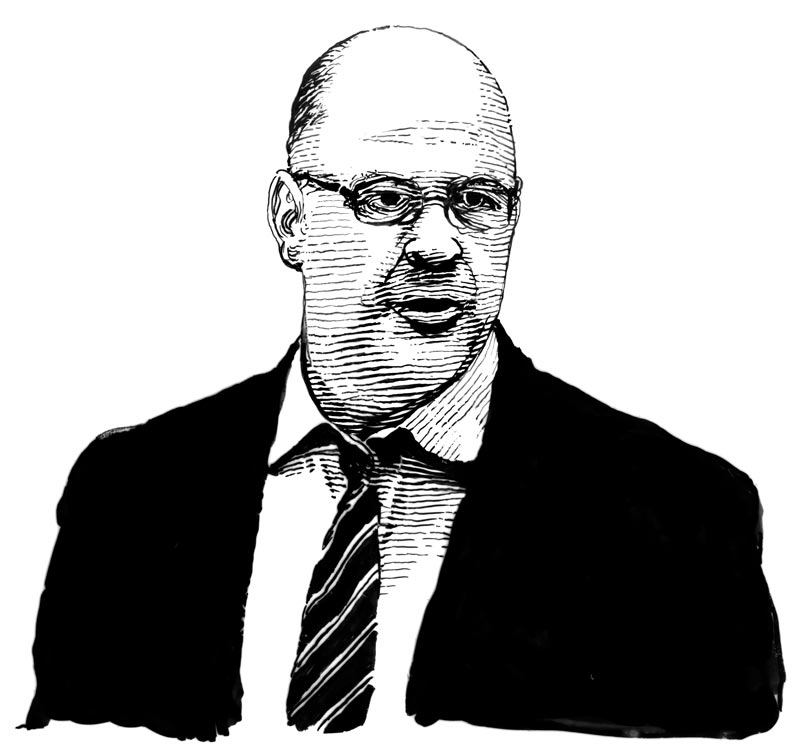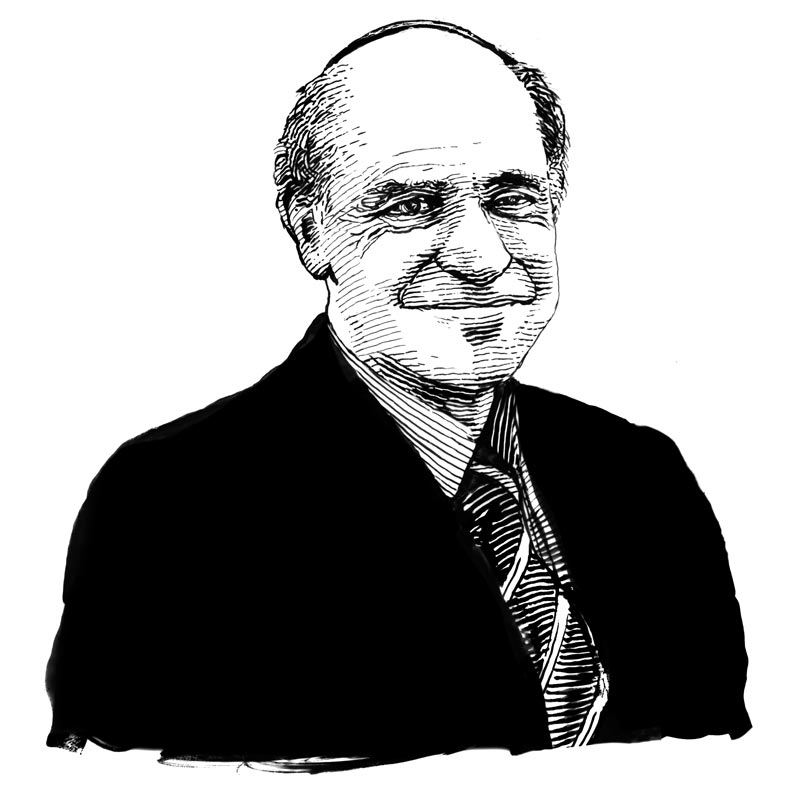In the Name of God
UVA team develops new approach to battling religion-based violence
Murderous extremists. Deadly drone strikes. Desperate refugees. Jerry White and Peter Ochs see a world aflame with killing in the name of God, and they want to fight fire with fire—and with data.
Religious violence has graphed a clear upward trend since 1989, according to the Hague Centre for Strategic Studies, and 2014 saw the most deaths from religious violence in 25 years.
Efforts to address this violence suffer because they exclude religion itself from the solution, Peter Ochs says. The theologian and UVA professor of modern Judaic studies is a leading intellectual force behind scriptural reasoning, an international discipline in which members of different faiths discuss their sacred texts in a way that engenders trust. Scriptural reasoning has been applied to social issues on a small scale, such as reducing tension and conflict in London between Christians, Muslims and Jews, but Ochs and Jerry White want to make it one element of a global campaign.
They are key figures in the Global Covenant of Religions, a new organization that aims to combat violence in the name of religion by enabling collaboration among religious leaders, governments and civil organizations. Gathering insight from the many “peace-building” efforts around the world, the Covenant proposes to bring to bear both the deep, shared values of world faiths and the revelations of computer modeling and game theory.
“This is trying to connect the streams, to flow into a river that reaches an ocean of impact,” says White, who shared in the Nobel Peace Prize in 1997 and is a visiting professor at UVA this year. “The thing I like about that image is that it’s moving, it’s dynamic, it has parameters, it’s heading somewhere that’s bigger than all of us.”
Scripture can be “weaponized,” Ochs says, when the relationship between it and the community breaks down and the values steeped in that relationship by time and tradition are discarded. “Neophytes misinterpret literal as authoritative,” Ochs says. “The victim is the language itself. It’s being deprived of its meaning. It’s no longer sacral.”
Or, as White puts it, scripture can be cherry-picked to justify mass murder—“You’re going to hell and I’m going to push you there.”
The Covenant describes its goal as an “ecology of collaboration” among three elements of society: Religious leaders delegitimize justifications for violence and draw on their communities’ resources for peace and justice. Governments deploy diplomacy, laws—and military force—and advance policies that promote security. Civil and community networks aid survivors and refugees, building resiliency and fostering collective action.
Launched in 2014, the Covenant is led by White, who serves as executive co-chair of a seven-member international board that includes theologians and experts in conflict diplomacy and humanitarian aid. The members are accustomed to working with governments, aid organizations, academic institutions and diverse leaders including the Dalai Lama, King Abdullah II of Jordan, the archbishop of Canterbury, and Vatican-based advisers to Pope Francis.
The organization has issued a call to religious leaders, academics and experts to join its working groups and to provide insight and research about law and policy, causes of violence, best practices, media strategies and religious dialogue. The Covenant especially hopes to engage women and young people, as the organization believes both groups are underrepresented in campaigns against violence, although they are often the most susceptible to the influence of extremists.
By fall 2016, the organization hopes to see collaborative projects in the Middle East, North Africa and South Asia, where religious violence is suffered disproportionately. The principles could also be applied to foster interreligious understanding to counter rising anti-Semitism in Europe, anti-Muslim violence in China, attacks on Christians in Pakistan or the persecution of other faiths around the world.
Survivor Turned Activist
White brings years of experience—and results—in global campaigns for social impact. His work is rooted in personal experience: In 1984, on a trip to Israel as a student at Brown University, White lost the lower part of his right leg when he stepped on a Golan Heights landmine, a remnant of the 1967 Six-Day War. He shared in the Nobel Peace Prize in 1997 for the International Campaign to Ban Landmines, which resulted in a major international treaty. As co-founder of the Landmine Survivors Network, later Survivor Corps, he was instrumental in campaigns that in 2006 led to the U.N. Convention on the Rights of Persons with Disabilities and in 2008 led to the Convention on Cluster Munitions, a treaty that outlaws weapons that scatter “bomblets,” which can remain unexploded years after a conflict has ended.

As deputy assistant secretary of state, leading the Bureau of Conflict and Stabilization Operations from 2012 to 2014, White delved into agent-based modeling, which uses computers and game theory to play out hypothetical scenarios and predict outcomes to real situations in international relations—Vladimir Putin’s next likely move in Crimea, for example, or the probable Saudi response to natural gas undercutting the price of oil.
The Global Covenant seeks to apply that modeling in search of “optimal paths” to address religion-related violence. Identifying potential responses includes diagnosing causes—a failed state, a malignant ideology, local social and economic injustice, the corruption of a religious narrative, and geopolitical pressures, among others. Or the model can introduce new elements into an existing situation. For example, what might be the effect on the Syrian refugee crisis if Pope Francis met with Iranian Supreme Leader Ayatollah Khamenei? The computer detects patterns and can shuffle variables to yield different results.
Results matter to White, but he looks beyond the short term. In his weekly class, Special Topics in International Relations: Religion, Violence, Strategy, he teaches strategy and planning for social action campaigns and engages the class as a laboratory for recommendations to the Global Covenant. Assignments include interacting with international aid organizations about real-world problems and programs. White is confident that he is training a new generation of leaders.
Lital Firestone (Col ’16), a fourth-year student from Bethesda, Maryland, was White’s teaching assistant in the spring. Where other political science classes can be abstract and impersonal, she says, White makes students identify what personal passion will motivate them to actually do the hard work of social action.
Born in Jerusalem and surrounded in childhood by holy sites of the three Abrahamic religions, Firestone says she believes religions can exist in the same place and their practitioners can work together to bring about a greater good rather than be the cause of violence. As she envisions a career in the developing world, she has adopted an idea embedded in the Global Covenant’s approach—that trust comes not from setting aside differences in belief but from exploring them openly. “That’s when you lean into the discomfort and see the other perspective,” she says. “That’s when you learn.”
Theologian with a Mission
A crucial component of the Global Covenant is the practice of scriptural reasoning, developed over the past 20 years by Ochs and a small group of international scholars. It holds that discussing scripture among members of different faiths is illuminating and trust-building, not because participants discover points of ethical or moral agreement but because talking honestly and listening to different interpretations of scripture reveals deep, shared connections to God. And those connections are a well of hope, peace and justice—necessary wisdom in a world fractured by religious violence.
“Within every community are places where people turn to draw on their deepest values, especially people in a conflict,” Ochs says. “Unless the route to peace can be translated into those deep roots, the group won’t accommodate itself to the solution.”
For example, rival communities might meet to work out rules for distributing limited water and food. Having reached a place of mutual trust by sharing, they would be more likely to find compassionate solutions.

To Ochs, engaging religion is an indispensable—but too often absent—part of building peace in an increasingly religious world. “The world is burning,” he says. “One cause of it is religious-related violence. But equally significant is the failure of governments and secular, civil society to know how to put out the fire. It’s not only that they don’t see the role of religion in violence, but they don’t see the role in peace, either.”
Ochs was an adviser to White at the State Department. He says U.S. Foreign Service officers felt inhibited from engaging with people whose primary focus was theological. A State Department paper in 2012 ascribed that reluctance to a department culture overly wary of violating the separation of church and state and predisposed to seeing religion as a divisive factor in foreign affairs.
“There’s been a shocking absence of wisdom, globally, in how this issue is approached,” Ochs says. “Diplomats, international studies scholars and policymakers have failed to recognize that religion is an ongoing, inveterate dimension of human reality. Misunderstanding the First Amendment has been a deep prejudice.”
How to Reach the People
The fighter wielding a rocket launcher or wearing a suicide vest may not be open to the Global Covenant’s appeal for peace. But that’s not who the movement needs to reach and mobilize.
White says the numbers are on the side of peace. “The majority of the world are religiously affiliated. And the majority of those don’t want to kill. Even if they regard someone as the enemy, they don’t want to kill in the name of God. Most people aren’t ISIS and would never want to join ISIS. The fringe—the criminal, terror fringe—remains just that, something to contain or criminalize or punish appropriately. But it’s not the majority of the story.”
White says containment and punishment—the military response—is necessary but out of balance in the campaign against ISIS. More needs to be done to rehabilitate the region through social reform, education, health care and interreligious understanding.
Organized and inspired, he says, the majority would exercise the Golden Rule as a balm against violence. In a column in May, Georgette Bennett, a leader of multifaith humanitarian aid and Global Covenant board member, cites the example of Israeli Jews partnering with Syrian Muslims to aid refugees from Syria—demonstrating by action that being of different faiths doesn’t mean they must be enemies.
Whether through religious wisdom or software-sorted data, the solutions to religious violence don’t come quickly, but the urgency is obvious. White says the organization will “hurry, slowly.” He knows the scale of the challenge. He expects skepticism. Yet he has faith that the Global Covenant of Religions will result in systemic change, as his other campaigns have done.
“What is faith?” he asks, and answers with the Apostle Paul’s formulation in Hebrews: “Confidence in things unseen.”
